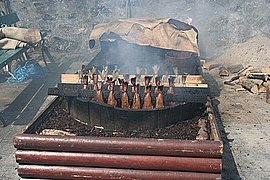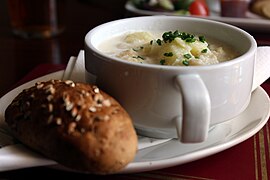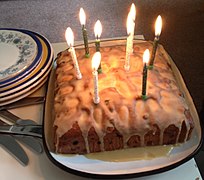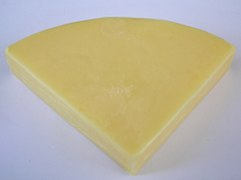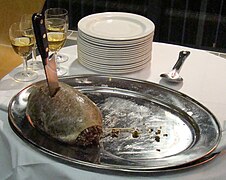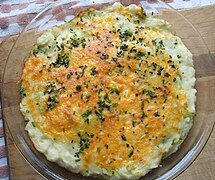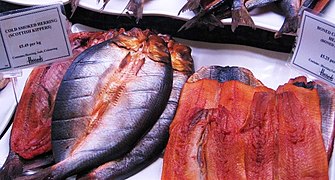Scottish cuisine
This article needs additional citations for verification. (October 2021) |

| British cuisine |
|---|
 |
| National cuisines |
| Regional cuisines |
| Overseas/Fusion cuisine |
| People |
|
|
| Part of a series on the |
| Culture of Scotland |
|---|
 |
| People |
| Mythology and folklore |
| Cuisine |
| Religion |
| Art |
| Literature |
Scottish cuisine (Scots: Scots cookery/cuisine; Scottish Gaelic: Biadh na h-Alba) encompasses the cooking styles, traditions and recipes associated with Scotland. It has distinctive attributes and recipes of its own, but also shares much with other British and wider European cuisine as a result of local, regional, and continental influences — both ancient and modern.
Scotland's natural larder of vegetables, fruit, oats, fish and other seafood, dairy products and game is the chief factor in traditional Scottish cooking, with a high reliance on simplicity, generally without the use of rare (and historically expensive) spices found abroad.
History
[edit]Scotland, with its temperate climate and abundance of indigenous game species, has provided food for its inhabitants for millennia. The wealth of seafood available on and off the coasts provided the earliest settlers with sustenance. Agriculture was introduced, and primitive oats quickly became the staple.[1]
Medieval
[edit]From the journeyman down to the lowest cottar, meat was an expensive commodity, and would be consumed rarely. For the lower echelons of mediaeval Scots, it was the products of their animals per se, rather than the beasts themselves which provided nourishment.
This is evident today in traditional Scots fare, with its emphasis on dairy produce. A typical meal in medieval Scotland consisted of a pottage of herbs and roots (and when available some meat, usually seafood, or stock for flavouring), with bread and eggs, cheese or kelp when possible.
Scotland was a feudal state for the greater part of the second millennium. This put certain restrictions on what one was allowed to hunt, therefore to eat. In the halls of the great men of the realm, one could expect venison, boar, various fowl and songbirds, expensive spices (pepper, cloves, cinnamon, etc.), and the meats of domesticated species.
Before Sir Walter Raleigh's introduction of the potato to the British Isles, the Scots' main source of carbohydrate was bread made from oats or barley. Wheat was generally difficult to grow because of the damp climate. Food thrift was evident from the earliest times, with excavated middens displaying little evidence of anything but the toughest bones. All parts of an animal were used.
The mobile nature of Scots society required food that should not spoil quickly. It was common to carry a small bag of oatmeal that could be transformed into a basic porridge or oatcakes using a girdle (griddle). It is thought that Scotland's national dish, haggis, originated in a similar way: A small amount of offal or low-quality meat, carried in the most inexpensive bag available, a sheep or pig's stomach. It has also been suggested that this dish was introduced by Norse invaders who were attempting to preserve their food during the long journey from Scandinavia.[2]
Early Modern period
[edit]During the Early Modern period, French cuisine played a role in Scottish cookery due to cultural exchanges brought about by the "Auld Alliance".[3] When Mary, Queen of Scots returned to Scotland, she brought an entourage of French staff who revolutionised Scots cooking and created some of Scotland's unique food terminology. These terms include Ashet (assiette), a large platter;[4] Cannel (cannelle), cinnamon; Collop (escalope); Gigot, French for a leg of mutton;[4] Howtowdie (hétoudeau), a boiling fowl in Old French;[4] Syboe (ciboule), spring onion.[5]
18th and 19th centuries
[edit]With the growth of sporting estates and the advent of land enclosure in the 18th century, harvesting Scotland's larder became an industry. The railways further expanded the scope of the market, with Scots grouse at a premium (as today) on English menus shortly after the Glorious Twelfth.
In the 19th century, Charlotte, Lady Clark of Tillypronie collected recipes throughout her life by asking society hostesses or cooks, and then testing them for herself at Tillypronie (Aberdeenshire). These were published posthumously in 1909 as The Cookery Book of Lady Clark of Tillypronie.[6][7][8][9]
20th and 21st centuries
[edit]The availability of certain foodstuffs in Scotland, in common with the other parts of the United Kingdom, suffered during the 20th century. Rationing during the two World Wars, as well as large-scale industrial agriculture, limited the diversity of food available to the public. Imports from the British Empire and beyond did, however, introduce new foods to the Scottish public.
During the 19th and 20th centuries there was large-scale immigration to Scotland from Italy, and later from the Middle East, India, and Pakistan. These cultures have influenced Scots cooking dramatically. The Italians reintroduced the standard of fresh produce, and the late comers introduced spice. With the enlargement of the European Union in the early years of the 21st century, there has been an increase in the population of Eastern European descent, from Poland in particular. A number of speciality restaurants and delicatessens catering for the various new immigrants have opened in the larger towns and cities.
Dishes and foods
[edit]These dishes and foods are traditional to or originate in Scotland.
Cakes, breads and confectionery
[edit]- Bannocks, flat quick bread
- Berwick cockles, white-coloured sweet with red stripes
- Black bun, a fruit cake completely covered with pastry
- Butteries/rowies, a savoury bread roll
- Caramel shortbread
- Drop scones, a type of pancake
- Dundee cake, a fruit cake with a rich flavour[10][11]
- Edinburgh rock, a soft and crumbly confection
- Empire biscuit, two shortbread biscuits with jam between, white icing and a cherry on top
- Fatty cutties, a girdle cake
- Festy cock, an oatmeal pancake
- Fruit slice or Flies' graveyard, sweet pastries with currants or raisins
- Granny sookers, sour, hard, boiled sweet or a peppermint sweet, also known as a pan drop
- Hawick balls, peppermint-flavoured boiled sweet
- Jethart Snails, boiled sweets in the shape of a snail
- Lucky tattie, white fondant with cassia, covered with cinnamon
- Moffat toffee, notable for its tangy but sweet centre
- Morning rolls, airy, chewy bread rolls
- Oatcakes, flatbread similar to a cracker, biscuit, or pancake
- Pan drops, a white, round, mint-flavoured boiled sweet with a hard shell and soft middle
- Pan loaf, a bread loaf baked in a pan or tin
- Penguin biscuit
- Petticoat tails, a type of shortbread
- Strippit baws, aniseed-flavoured hard boiled sweet
- Plain loaf, formerly and traditionally the most common form of bread
- Puff candy, sugary toffee with a light, rigid, sponge-like texture
- Scones
- Scots crumpets, broadly similar to the pikelet
- Scottish macaroon, made with a paste of potato and sugar, and often chocolate
- Selkirk bannock, variations include Yetholm bannock—types of flat quick bread
- Shortbread, biscuit usually made from sugar, butter, and wheat flour
- Soor ploom, sharp-flavoured, round, green boiled sweet
- Tablet, a medium-hard, sugary confection
- Tattie scone (potato scone), a Scottish variant of the savoury griddle scone
- Well-fired rolls, a more strongly-flavoured morning roll
Cereals
[edit]- Brose, an uncooked porridge
- Porridge
- Sowans, a sour oat porridge
- Skirlie, oatmeal fried with fat, onions and seasonings
Dairy
[edit]- Bishop Kennedy, soft, round, brie-like cheese with a yellowish runny interior
- Bonchester, soft cheese with a white rind
- Caboc, cream cheese
- Crowdie, soft, fresh cows' milk cheese
- Dunlop cheese, originating in Dunlop in East Ayrshire[12]
- Gigha, a Dunlop-style cheese, long-produced on the Isle of Gigha[13]
- Lanark Blue, a rich, blue-veined artisan sheep's milk cheese
- Teviotdale cheese, full-fat, hard, cows’ milk cheese
Fast food and takeaway
[edit]- Deep-fried Mars bar, a novelty confection deep-fried in fish and chip shops
- Fish and chips, fried fish in crispy batter, served with chips
- Haggis pakora
- Munchy box, a selection of takeaway items served in a pizza box
Fish and seafood
[edit]- Arbroath smokies, a type of smoked haddock, a speciality of the town of Arbroath in Angus
- Cabbie claw (cabelew), young cod in white sauce with chopped egg whites
- Crappit heid, fish head stuffed with oats, suet and liver
- Eyemouth pale, cold-smoked haddock with light golden hue and subtle smoky flavour
- Finnan haddie, another cold-smoked haddock originating in Findon, Aberdeenshire
- Kippers, a whole herring butterflied, salted or pickled, and cold-smoked
- Kedgeree, a dish containing rice, smoked haddock, eggs, parsley, butter or cream
- Rollmops, pickled herring rolled up with onion, gherkin or green olive, with pimento (on a stick)
- Scampi
- Smoked salmon
- Tatties and herring
Fruit
[edit]- Blaeberries - not identical to US blueberries, cf.
- Raspberries
- Slaes
- Strawberries
- Tayberries
Meat, poultry and game
[edit]- Ayrshire middle bacon, a specially cured bacon
- Black pudding, red pudding and white pudding, savoury puddings consisting of meat, fat and cereal
- Boiled gigot, a leg of mutton or lamb
- Forfar bridie, a meat and onion-filled pastry
- Chicken tikka masala, roasted marinated chicken in curry
- Collops, an escalope, thick slice of meat off the bone cut across the grain
- Haggis, a savoury pudding containing sheep's pluck (heart, liver and lungs) and several other ingredients, often considered the national dish of Scotland
- Howtowdie with Drappit eggs, young hen with poached eggs
- Kilmeny Kail, a dish originating in Fife consisting of rabbit, bacon, and either cabbage or kale
- Mince and tatties, minced beef with potatoes, onions and often carrots
- Mutton ham, lamb ham
- Pottit heid (brawn), a head cheese
- Potted hough, another head cheese
- Reestit mutton, salted meat traditional to the [Shetland Islands]] and considered the archipelago's "national dish"
- Roast Aberdeen Angus beef
- Roast haunch of venison
- Roast grouse
- Roast woodcock/snipe
- Solan goose or guga (gannet) in the Western Isles
- Scotch pie, a double-crust meat pie, usually containing mutton
- Lorne sausage, a square-shaped sausage meat, not encased and mostly served for breakfast
- Stovies, slow-stewed potatoes, often onions and meat
Preserves and spreads
[edit]Puddings and desserts
[edit]- Apple frushie (variant of apple tart)
- Burnt cream, also known as Crème brûlée or Trinity cream.
- Blaeberry pie
- Carrageen moss, a milk pudding thickened with seaweed
- Clootie dumpling, a traditional pudding made with flour, breadcrumbs and dried fruit
- Cranachan, similar to Atholl Brose, a dessert containing cream, oats, whisky and sometimes raspberries
- Hatted kit, a milk pudding
- Marmalade pudding, made with stale bread, dried fruit, marmalade, milk and eggs
- Stapag, Fuarag, oats with cold water and cold milk respectively
- Tipsy laird, a trifle made with whisky or Drambuie, custard and raspberries
Soups
[edit]- Cullen skink, a thick soup made of smoked haddock, potato and onion
- Baud bree, hare broth
- Cock-a-leekie, a soup made with leeks, peppered chicken stock, often served with rice or barley
- Game soup, a soup made of meat products found in game
- Hairst bree (or hotch potch), a one-pot dish, usually with lamb or mutton and seasonal vegetables
- Partan bree, seafood soup with crab and rice
- Powsowdie, a Scottish sheep's heid (head) broth or soup
- Scotch broth, soup with barley, lamb or mutton and root vegetables
Vegetables
[edit]- Clapshot, a side dish made with potatoes, swedes, chives and butter, served with oatcakes
- Curly kail
- Neeps and tatties (swede turnip and potatoes)
- Rumbledethumps, a traditional dish from the Scottish Borders with main ingredients of potato, cabbage and onion, similar to Bubble and squeak
-
Cullen skink (right), served with bread
-
Haggis on a platter at a Burns supper
-
A dish from the Scottish Borders, rumbledethumps
-
Scottish kippers, for sale in Harrods
Drinks
[edit]Alcoholic
[edit]
- 90 shilling ale, 80 shilling ale, 70 shilling ale
- India pale ale
- Atholl Brose, a cocktail prepared using oatmeal brose, honey, whisky, and sometimes cream (particularly on festive occasions)
- Crabbie's
- Drambuie
- Ginger wine
- Het pint, hot spiced ale to which sugar, eggs and spirits may be added
- Heather ale, flavoured with young heather tops
- Scotch ale
- Scotch mist, a cocktail containing mainly Scotch whisky
- Scotch whisky
Non-alcoholic
[edit]- Breakfast tea
- Irn-Bru, a bright orange carbonated soft drink
- Red Kola, a bright red carbonated soft drink
- Sugarelly
Fast food
[edit]Scotland's reputation for coronary and related diet-based diseases is a result of the wide consumption of fast food since the latter part of the 20th century. Fish and chip shops remain extremely popular, and indeed the battered and fried haggis supper remains a favourite. In the area around Edinburgh, the most popular condiment for chip shop meals is "salt and sauce", the sauce element consisting of brown sauce thinned with water and vinegar. However in Glasgow, and elsewhere, chippy sauce is unknown and ketchup or salt and vinegar are preferred, prompting light-hearted debate on the merits of the options among the cities' residents, who tend to find the alternative a baffling concept.[14][15][16][17]
Outlets selling pizzas, kebabs, pakoras and other convenience foodstuffs have also become increasingly popular, with an extreme example of this style of food being the Munchy box.[18]
In addition to independent fast-food outlets, in the 1960s American-style burger bars and other restaurants such as Wimpy were introduced, and in the 1980s, McDonald's, Burger King, Pizza Hut and Kentucky Fried Chicken appeared in Scotland, followed by a large number of Subway franchises in the early 21st century. Branches of Greggs offering cakes, pastries and sandwiches are also very commonly found on the high streets of Scotland, often alongside smaller competing bakeries.[citation needed]
In recent years, Haggis pakoras have become popular in Indian restaurants.[19]
Chefs
[edit]See also
[edit]Notes and references
[edit]- ^ "Scotland's Traditional Cuisine – a brief overview", Taste of Scotland
- ^ "Haggis History". MacSweens of Edinburgh. Archived from the original on 4 September 2006. Retrieved 23 October 2006.
- ^ Gail Kilgore. "The Auld Alliance and its Influence on Scottish Cuisine". Retrieved 29 July 2006.
- ^ a b c Brown, Catherine (1989). Chapter 9: "Culinary Interchange". In: Scottish Cookery. Glasgow: Richard Drew Publishing. ISBN 0-86267-248-1.
- ^ "Dictionary of the Scots Language :: SND :: Sybow n."
- ^ Frere, Catherine Frances (editor). (1909) The Cookery Book of Lady Clark of Tillypronie. London: Constable and Company. OCLC 752897816.
- ^ Woolf, Virginia (25 November 1909). "The Cookery Book of Lady Clark of Tillypronie". Times Literary Supplement.
- ^ Anon (27 November 1909). "The Cookery Book of Lady Clark of Tillypronie". The Spectator. p. 25. Retrieved 8 December 2014.
- ^ Holt, Geraldene. "Essays and Introductions". Retrieved 8 December 2014.
- ^ Elizabeth, Hinds. "Classic Scottish Cakes". Cake Baker. Retrieved 19 November 2011.
- ^ "Dundee Recipe Is Another Standby for the Holidays". The Evening Independent. St. Petersburg, FL. 13 November 1936. p. 13. Retrieved 19 November 2011.
- ^ MacIntosh, John (1894). Ayrshire Nights Entertainments: A Descriptive Guide to the History, Traditions, Antiquities, ect. of the County of Ayr. Kilmarnock. p. 265.
- ^ Off the Chain: Notes and Essays from the West Highlands. Palmer. 1868.
- ^ "Scotland's sauce wars: Charge for ketchup in Edinburgh leaves customer from Glasgow with chip on shoulder". The Independent. 27 August 2013. Retrieved 22 March 2019.
- ^ "Glasgow chippies get ready for the 'salt and sauce' Scottish Cup Final". Daily Record. 18 April 2012. Retrieved 22 March 2019.
- ^ "Salt 'n' sauce? Capital chippy sauce export bid". Edinburgh Evening News. 6 April 2013. Retrieved 22 March 2019.
- ^ "Karen Gillan wants Scottish chip sauce – so, what is it?". Radio Times. 18 June 2015. Retrieved 22 March 2019.
- ^ "What is a Munchy Box?". 23x.net. 8 June 2008. Retrieved 27 October 2009.
- ^ Shaheen (27 January 2010). "Mushroom haggis pakoras with curried neep chips". Allotment2Kitchen. Retrieved 23 August 2015.
Further reading
[edit]- Beckwith, Lillian (1976). Lillian Beckwith's Hebridean Cookbook. London: Hutchinson ISBN 978-0-09-127380-4.
- Craig, Elizabeth (1956). The Scottish Cookery Book.
- Craig, Elizabeth (1965). What's Cooking in Scotland.
- Craig, Elizabeth (1980). The Scottish Cookery Book.
- Frere, Catherine Frances (editor) (1909). The Cookery Book of Lady Clark of Tillypronie. London: Constable and Company.
External links
[edit]- Scottish Food – Scottish Food & Drink

